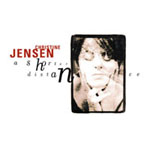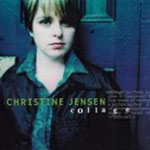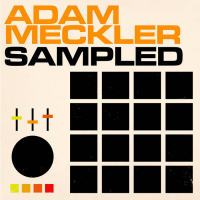Home » Jazz Articles » Interview » Christine Jensen: Looking Left
Christine Jensen: Looking Left
I think the big thing for me was, before doing [my first] album, was having people support me and say, "You're ready to do this."
 The Globe and Mail called saxophonist and composer Christine Jensen "one of the most important Canadian composers of her generation." She grew up with her trumpet-playing sister Ingrid near Vancouver, though she's now based in Montreal. Jensen has recorded three albums. Her most recent project is Look Left (Effendi, 2006), the result of a half-year spent studying and writing in Paris.
The Globe and Mail called saxophonist and composer Christine Jensen "one of the most important Canadian composers of her generation." She grew up with her trumpet-playing sister Ingrid near Vancouver, though she's now based in Montreal. Jensen has recorded three albums. Her most recent project is Look Left (Effendi, 2006), the result of a half-year spent studying and writing in Paris.
AAJ contributor Jason Crane caught up with Jensen to talk about life along the Seine, Plato and Lee Konitz.
All About Jazz: Let's dig right in with a quote from the liner notes about the title track, "Look Left." You said: "'Look Left' developed into a political theme representing my opposition to the invasion of Iraq by Bush and Blair." This is an instrumental tune. How do you feel jazz musicians are able to communicate political protest if they don't have the benefit of lyrics?
Christine Jensen: With that tune, it really was a bit of emotion that hit me at the time. I was living in Paris. I had a six-month residency there, right in the heart of Paris, and I was traveling a bit to London as well. It was the summer of 2002—post 9/11—and there was a lot of heated discussion and debate and marches going on. A lot of people in France and England were uprising against the choices their governments might make going into the impending invasion.
So I got an Eastern theme with this kind of melancholy, Chopin-esque bass line hovering around the key of F#. [plays melody on piano] It's this haunting little theme. I think of flutes—a "marching in the distance" feeling. And then I think on the recording the band gets into it. We're all big fans of Wayne Shorter's new band, and we tried to go for a group improvisation in it.
AAJ: You mentioned that you were in Paris because you got a grant, which came from the Council of Arts and Letters of Quebec. Talk about that residency and what a completely different environment did for your composing. How was it different to be in a studio overlooking the Seine rather than in Montreal?
CJ: A lot of jazz musicians have lived in [that same area] in the past because of this residency. And you really get the feel of what it must have been like in the turn of the century in France when all these artists were there, and they were creating this new source of what was to come of art. Then to be there 100 years later or more, and everything is still as stunning as ever. I think visually it's one of the most vibrant cities to get inspiration from, just walking around.
I had a choice to play a lot and meet people or to get more introspective. I think I'd gone through a lot of playing the year before, and I tend to go in waves of playing or writing. So this was a great experience to be writing in. Then I'd have people over to play my music.
AAJ: What was the point of the grant? Was it to get away for six months without financial pressure?
CJ: Yeah. It was a great gift from the government here. They have a few of these all over Europe and also one in New York that a lot of Quebec musicians use. I think I was very spur-of-the-moment in applying for that studio. It's very hard to get because it's multi-disciplinary. A lot of great writers and artists are going up against me when they do the juries. I was very fortunate to put up a project that they thought would benefit my future, and it sure did because I wrote the most I've ever written in a short amount of time by being there.
AAJ: You mentioned how vibrant Paris's Marais district is. I think my favorite piece on this new record is "Promenade." If I'm reading the liner notes correctly, that was one of the pieces most directly inspired by the area in which you were living.
CJ: I had just come off a tour of Canada, and when you do a tour of Canada—we're very into latitude rather than longitude here. I spent quite a bit of time running around doing some larger ensemble projects. So I actually arrived in Paris quite exhausted from the previous few months of work. I got there and this woman said, "The Place de la Seine is going on," which is where they dump all this sand on the main thoroughfare running along the Seine. No traffic goes on it, it's all pedestrians. They put beach towels and chairs and sand and they have volleyball and all these sports going on. It was literally outside my door.
I hadn't experienced Paris in the summer before, so I just landed in this building right on the edge of this. I was like, "What is going on down there?" It was this huge extravagant party for the public along the Seine. So that was my "Promenade." Also, for a couple of weeks I was walking miles and miles every day because there was so much to take in that way. AAJ: In terms of geographic inspiration for this record, it can't get too much more different than it is. It runs from Paris to an area that I'm sure has inspired a lot of great jazz: Fargo, North Dakota ("Upper Fargo").
AAJ: In terms of geographic inspiration for this record, it can't get too much more different than it is. It runs from Paris to an area that I'm sure has inspired a lot of great jazz: Fargo, North Dakota ("Upper Fargo").
CJ: [laughs] That was my trippy one. I've never been there. At the time, The Corrections had come out, by Jonathan Franzen, and he describes in this book—which is fiction but I think also comes from his Midwest experience growing up—a cocktail party with his family. They kept up appearances all the time by going to these events. He's in New York writing about all this stuff and he thought of their idea of "upper middle class." And I combined that by thinking of the Upper East Side in Manhattan or Upper Lonsdale in Vancouver. There are all these "upper" places where it's a little more upscale. So I imagined one in Fargo, North Dakota.
That piece stems a lot from listening to Dewey Redman and Pat Metheny from the 1970s or early '80s. That Midwest vibe of those two players. It was a fantasy. Sometimes I think I'm trying to create a very fictional piece of music inspired by the music I listen to as well as literature and arts that influence my writing.
AAJ: If we move a little further west, we get closer to your place of origin in Vancouver with a tune called "Cedar."
CJ: That's a work in progress. I just got to add on to that one recently. My sister Ingrid, who's a wonderful trumpeter in New York, and I grew up in Cedar, which was this little tiny farm area south of a midsize mill town called Nanaimo. That place is called Cedar for a reason because those trees were everywhere. They were just immense trees in the West Coast rainforest.
We had a park next to us that was my fantasyland. I'd jump the creek and go into this dense forest that was right next to us and try to climb these trees, which were very hard to climb. It was a dense forest, but if you can climb high enough you start to see some light at the top. You can hear these ascending and descending lines [in the piece]. On top of that, I was in a pretty melancholy state when I wrote that piece around Christmas. I had really wanted to go home that Christmas, so I wrote a few things that were about wishing I was home.
AAJ: Tell us about your mom and the role she played in your musical upbringing.
CJ: I have two older sisters, and that was my mother's outlet. She was a schoolteacher by day, and also a music teacher who taught private piano lessons for kids. She was also very involved in musical theatre. Even going back to my grandmother, she had the same background. They had music around them all the time and it was always live music. My mother had a small but quite tasteful record collection, so we were listening to everything from Chopin to Oscar Peterson. A lot of piano trios and then a lot of dance band stuff like Tommy Dorsey and some older singers. She always was tuning our ears to something different than most kids around us were growing up with.
We'd try to play [pop music for her]. She wouldn't listen to pop music. It was pretty hard to convince her that it was as good as what she'd been listening to. And she had a point in the 1980s. She was a wonderful, positive force in our lives. She was also really great at making us active in music. She would sign us up for every seminar and course that she could get us into because she knew we loved it and it kept us in a really positive mental state.
AAJ: So it sounds like it wasn't a chore for you.
CJ: No. I started on piano. It's funny, because I've been talking to [composer] Maria Schneider and [pianist] Maggie Olin about this, and we've all had similar experiences of sitting at the piano and doing exercises, then we'd try to escape and make up our own variation on it. My mother was wonderful at letting us try to figure out our creativity level.
AAJ: And a jazz musician is born.
CJ: [laughs] That and the combination of teachers who played jazz in our high school. That was a huge thing.
AAJ: You went to high school in Nanaimo?
CJ: Yeah. That's also where [pianist] Diana Krall went to school. She was a big influence because she was one of the first to really get into jazz. The town is about 50,000 [people], or it was at the time. There were four or five junior high schools feeding into one big high school. So the band director at the high school was very fortunate—he had four or five other guys training kids at a pretty high level. Then they'd get into their last two grades and we'd have a lot of big band stuff going on.
AAJ: Do you have a copy of Look Left in front of you? I'd like you to read the quote from Plato that used to hang over your mom's piano.
CJ: It's funny, because it was always in front of me and I never read it until she passed away. It's a really great quote. I sat down and started crying over it one day. It says:
Music is a moral law
It gives soul to the universe
Wings to the mind
Flight to the imagination
A charm to sadness
Gaiety and life to everything
It is the essence of order and lends to all
That is good, just and beautiful
AAJ: Not a bad way to live. CJ: Exactly. Look what my mother had in front of her all the time. It took us a while to notice it, but it rings true.
CJ: Exactly. Look what my mother had in front of her all the time. It took us a while to notice it, but it rings true.
AAJ: How did you make the leap, and when did you, from piano to the saxophone?
CJ: In grade six, we joined band programs. My two older sisters—one played trumpet and one played trombone. They would always talk about, "What instrument is Christine going to play?" Ingrid would say, "I play the trumpet and Janet plays the trombone, so to fill out our band we need Chrissy on the saxophone." I used to play recorder, and one of my teachers gave me the whole recorder family to take home one summer. That was a crazy experience that led very easily to the saxophone.
AAJ: What's the age difference between you and your sisters?
CJ: I'm the youngest. I'm four and a half years younger then Ingrid. My older sister Janet eventually left music and now lives in Mexico selling real estate in the sun. She played trombone and she was a few years older than Ingrid.
AAJ: So they had already moved through the music programs as you were coming up.
CJ: Yeah. It's a pretty large distance in age when you're younger. I couldn't get on the same stage with Ingrid before I was in my early twenties. She was that much older. I was always going between piano and saxophone. Eventually, once I finished my degree at McGill University, I [decided] that saxophone was it, that I had more of a personal voice to offer.
AAJ: So even that far into university you were still playing both piano and saxophone.
CJ: Exactly. My first few years I was playing piano more than saxophone because they needed piano players and I could comp and solo a bit, but my heart was not in the piano. I find it a technical beast to conquer. At the same time, I think the positive thing I got out of it was that I put some positive effort into it and that's helped me in the long run in terms of composition. To be able to just sit at the piano and play and get some ideas happening very fast. It's such an important tool for me.
AAJ: I'm going to betray my ignorance: Is McGill in Quebec?
CJ: Yes. In Montreal.
AAJ: So you decided to travel as far from your home as you could. What was the attraction of McGill? Was it the music program there? CJ: Yeah. We had all these choices in front of us. When I finished high school I went to college in Nanaimo. My sisters and I all did a couple years at Malaspina College first, which is now a university on the West Coast. We did a two-year program, which was basically a great time for us to sit and figure out a few things before moving to bigger cities. We were definitely small-town kids, and it gave us freedom to get the instrument together a little bit. Through that time, I was actually playing a lot of jazz piano.
CJ: Yeah. We had all these choices in front of us. When I finished high school I went to college in Nanaimo. My sisters and I all did a couple years at Malaspina College first, which is now a university on the West Coast. We did a two-year program, which was basically a great time for us to sit and figure out a few things before moving to bigger cities. We were definitely small-town kids, and it gave us freedom to get the instrument together a little bit. Through that time, I was actually playing a lot of jazz piano.
I applied to McGill because I'd heard their big band with a singer named Denzal Sinclaire. I heard him and thought, "That's incredible." Then I heard the John Stetch trio and thought that I'd never heard that level before in Canada. This was the late 1980s. So I thought it was a good school to go to. In Canada, it's a big school to get into. In fact, now a lot of Americans are going there. It's sort of the "Harvard of the North." They have a jazz program that's really a great program. And very intensive with the classical program as well. You have to do a lot of theory and counterpoint and ear training, which I have no problem with.
AAJ: By the time you graduated from McGill in 1994, had you already decided that being a professional musician was the course you were going to follow?
CJ: I think that was always in front of me. I never ignored it or accepted it. I was always working [as a musician], it was how I made money. I played solo piano in hotels on the West Coast and then I moved to Montreal and as a saxophonist was playing everything from Latin gigs to jazz trio to pop gigs. It's always been in front of me.
AAJ: So what was the next step after you left McGill?
CJ: I had some more doubts. Not doubts about being a musician, but about being a performing jazz artist. It was really hard for me to even say those words: "I'm a jazz musician." I was like, "I'm a student." I mean, I'm a student for life with the music. But I think after about five years Ingrid was really quite influential in giving me a lot of positive guidance. The next thing I knew I went down to New York and had a few lessons with Kenny Werner, and I was starting to get grants from the Canada Council to do composition, which was pretty major because I didn't think I was a composer. Ingrid was playing a lot of my music. She said, "Your music is accessible to people as well as being 'new jazz' sounds."
AAJ: You wrote the title track to her first record, Vernal Fields (Enja, 1995), right?
CJ: That was an undergrad assignment in composition.
AAJ: And it won a Juno Award in 1995 [the Canadian Grammy].
CJ: That's right. I didn't think that song would go so far, so fast. I was studying with a wonderful composition teacher named Jan Jiracek who was helping me. There's a big step between just writing a tune and making something good. He was guiding me through some traps I was getting myself into compositionally. It was pretty amazing. A few other tunes of mine got on there as well.
AAJ: You released your first album in 2000 [Collage (Effendi Records, 2000)]. What was that like?
CJ: It was such a process. I think the big thing for me was, before doing the album, having people support me and say, "You're ready to do this."
AAJ: Since then, you've released two albums including the present one. Will you talk about the folks who are on the new album, Look Left?
CJ: Sure. The previous two had more sextet writing with Ingrid and my husband Joel Miller on saxophone. He's also a phenomenal inspiration to me in writing, because he's a wonderful composer and player. For this one, I decided to make it a smaller group setting and focus on myself as a player. In fact, there's one composition on there that Joel wrote with my group in mind ["Mark Adam Drum"] because he really enjoys the drummer that I work with. Dave Restivo from Toronto is on piano. He works with [bandleader] Rob McConnell and does all sorts of new, innovative things out of that scene. He's around my age. We have a lot of the same influences, musically, which is interesting when you're on the road and you can talk about jazz in the 1980s and who we were listening to.
Dave Restivo from Toronto is on piano. He works with [bandleader] Rob McConnell and does all sorts of new, innovative things out of that scene. He's around my age. We have a lot of the same influences, musically, which is interesting when you're on the road and you can talk about jazz in the 1980s and who we were listening to.
Fraser Hollins is on the bass, and he's also around my age, so it's neat to be playing with these guys. Then we have Greg Ritchie, who's ten years younger but kicking up a storm on the drums. He lives in New York now. But they're all Canadians! And also Ken Bibace on the guitar, who I use more as a horn-line player. He also does some rhythm work on the guitar, but he's supporting my horn lines more, replacing the other two horns I used to have. It's a lot more intimate for me, especially with Dave. We have a great conversation together.
AAJ: What's coming up next for you and the band?
CJ: Lots of great things. We're playing at Dizzy's [at New York's Lincoln Center] on the last Monday of May, May 28, with Ingrid as our guest. Then the Burlington [Vermont] jazz festival on June 5. The Montreal Jazz Festival on July 6. And I think I have about fifteen dates across Canada in June and July.
AAJ: I want to ask you about a saxophonist you had a chance to become friends with in Paris. There's a tune on Look Left called "A Tree Thing" that's inspired by him. Will you talk about Lee Konitz?
CJ: Lee is the most beautiful person walking on Earth. I've only spent a bit of time with him, but he said, "You sound great," and I said, "Get outta here. You sound great." He listened to the first album I did and thought that Ingrid and I had a special sound together. For me, that's a really deep compliment coming from a man who is all about sound. We would just talk on the phone and walk around Paris together. He was spending quite a bit of time there working with François Théberge on a project. [François] is a friend of mine, so he hooked me up with Lee. It was great. [Lee's] such an influence on how I play the saxophone.
AAJ: How so?
CJ: One thing I admire about him is that he's done all these recordings, and if you go through them all, the majority of them are based on certain standards. Maybe twelve standards or something with a bit more after that. He's really an artist at innovating himself each time he plays "All The Things You Are" or "What Is This Things Called Love?" or "Alone Together." Each time I hear him, I find that his sound gets richer and richer through time and more strong. He's been strong since the beginning, but it's like he's constantly evolving from these basic forms. He's a huge figure in jazz who's been very under the radar the whole time for that reason.
Selected Discography
Christine Jensen, Look Left (Effendi Records, 2006)
Christine Jensen, A Shorter Distance (Effendi Records, 2002)
Christine Jensen, Collage (Effendi Records, 2000)
Photo Credits
Top Photo: Michel Laplante
Bottom Photo: Courtesy of Christine Jensen
Tags
PREVIOUS / NEXT
Support All About Jazz
 All About Jazz has been a pillar of jazz since 1995, championing it as an art form and, more importantly, supporting the musicians who make it. Our enduring commitment has made "AAJ" one of the most culturally important websites of its kind, read by hundreds of thousands of fans, musicians and industry figures every month.
All About Jazz has been a pillar of jazz since 1995, championing it as an art form and, more importantly, supporting the musicians who make it. Our enduring commitment has made "AAJ" one of the most culturally important websites of its kind, read by hundreds of thousands of fans, musicians and industry figures every month.


























